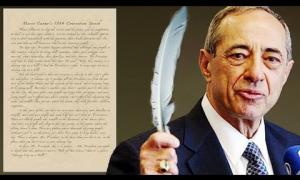Vision Makes a Leader
December 21, 2015
All the other qualities of leadership—qualities like courage, character, charisma and any others you care to name—are important to leadership only because they help the leader realize his vision.
I’ve lost track of the number of speeches I’ve written on leadership, but there’s a common thread that runs through all of them. Whether I spell it out in the text of the speech or not, it’s important to always keep in mind the difference between a manager and a leader.
The difference matters. In fact you could probably fill a book with short, pithy sayings about what makes the difference between a manager and a leader.
Peter Drucker and Warren Bennis had a good one when they said, “Management is doing things right; leadership is doing the right things.”
Stephen R. Covey, in The Seven Habits of Highly Effective People, illustrated the difference by using an analogy.
He put it this way: Imagine a group of people, cutting their way through a dense jungle with machetes. These are the producers, the problem solvers. They are clearing away the underbrush.
Behind the producers come the managers. The managers sharpen the machetes, write the policy and procedure manuals, hold muscle development programs and set the schedules and compensation packages for the people with the machetes.
Who is the leader in this scenario? According to Covey, he’s the one who climbs the tallest tree, surveys the entire situation, and yells, “Wrong jungle!”
To which the people on the ground will often reply, “Shut up! We’re making excellent progress!”
Don’t laugh. Ever see the movie, The Bridge on the River Kwai?
If you haven’t, it’s about a large group of British POWs in Burma during World War II. The POWs are forced to build a railroad bridge by their Japanese captors. The Japanese botch the job, because they don’t have the necessary engineering skills. When this happens, the POWs’ ranking officer, a British colonel played by Alec Guinness, takes charge of the operation and builds a successful bridge. He does this partly to shame the Japanese, and partly to keep his men busy and their morale high.
The colonel is a by-the-book type who becomes so obsessed with building the bridge that he loses sight of the larger fact that he is helping the Japanese war effort. It is only at the end of the picture that he realizes his mistake and cries out, “What have I done?!”
He was an excellent manager, but he lacked the vision to be a real leader.
So the first quality of a leader is vision. All the other qualities of leadership—qualities like courage, character, charisma and any others you care to name—are important to leadership only because they help the leader realize his vision.
Now, anyone can cultivate the secondary qualities of leadership. You can make a habit of being brave, honest and generous, for example. You can develop your powers of persuasion. You can be of service to your community.
You can broaden your knowledge base. You can keep learning, so you will have the wisdom you need to make high-level decisions. You can work at different jobs in order to better understand the business you are in and to better relate to the different people who work in that business. You can do all that and more – and you’ll be a more successful person for it. But without vision, you won’t be a leader.
A recent president of the United States once admitted to having trouble with what he unfortunately termed “the vision thing.” In the next election, he lost to a candidate who, in his convention speech, reminded the American people of a verse from Proverbs that says, “Where there is no vision the people perish…”
So in your next speech on leadership, be sure to rank vision first among the attributes of a real leader.


